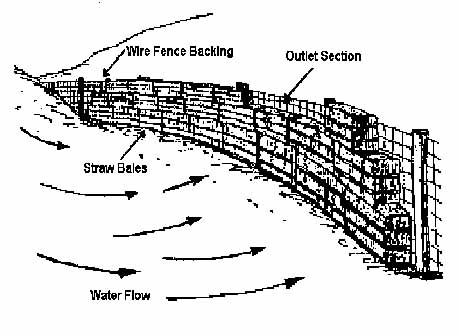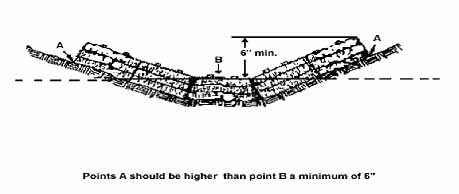| |
|
|
|
|
|
| |
|
| |
|
| Components |
|
| Surface Stabilization |
|
| It is important that all disturbed
areas are covered within 12 hours of the disturbance if they will
not be worked on for more than 2 days. (7 days from May 1st to September
30th.) This can be accomplished with a variety of products. |
|
| |
|
| Erosion Control Products |
|
|
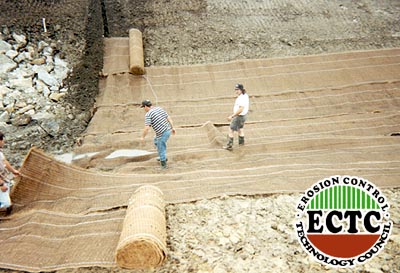
Figure 1: Erosion Control
Blankets
|
Erosion
Control Blankets
These blankets can be effective in minimizing the erosive effect
of rainfall when used to cover bare or newly planted soil. The
blanket stabilizes the soil to protect new plantings and reduces
the potential for introducing sediment into storm water run-off.
This product protects newly graded slopes, open areas, and drainage
swales to allow germination of seed mixes and plantings. It
is designed to provide short and long term temporary erosion
control. |
|
|
| |
|
Erosion Control Blankets are made from
biodegradable materials that can be used to protect disturbed slope
and channel areas from wind and water erosion. The blankets are made
from natural materials such as straw, wood excelsior, or coconut.
Alternatively, they can be manufactured from geotextile synthetic
woven materials such as polypropylene.
It is necessary to inspect the site before, during, and after installation
as well as significant rain events. All damaged materials must be
repaired or replaced. It is recommended that all soil washout areas
be re-compacted. |
|
| |
|
| Runoff Control |
|
| Erosion Control Structures |
|
Diversions
These are temporary measures used to prevent sediment laden water
from entering or exiting the construction site and until permanent
storm water drainage structures are installed. They are typically
used at the toe of cuts or fills to direct runoff to sediment traps.
They can also be used to divert clean water before it can enter a
disturbed area, providing time for the stabilization of soils. |
|
| |
|
|
Slope Drains
Commonly used for diversion, slope drains can be built from
a variety of materials such as PVC, galvanized, or flexible
piping, or a ditch lined with either a plastic liner or a
soil retention blanket. They are used in conjunction with
berms along the edges of fresh cut and fill slopes; stabilization
must be provided at the point of outlet.
Slope drains are relatively inexpensive
to build and most of the materials, if not damaged, can be
recycled for use in the next project.
|
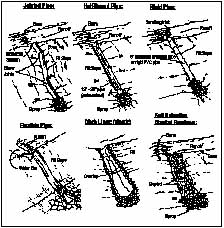
Figure 2: Slope Drains
|
|
|
| |
|
| Straw Bale Barriers |
|
|
|
|
| This type of barrier not only promotes
sheet flow and reduces runoff velocity, but it also retains transported
sediments. While very inexpensive to construct, they only have a life
span of three months. Since most large-scale construction projects
last much longer than this, the barriers would have to be replaced
on a regular basis, perhaps causing a more permanent structure to
be more cost effective in the long run. |
|
| |
|
| Outlet Protection |
|
| Erosion Control Products/Structures |
|
Riprap
A layer of stone designed to protect and stabilize
site areas that are subject to erosion, slopes that are subject to
seepage, or areas with poor soil structure. Riprap is also used on
slopes where vegetation cannot be established, channel slopes and
bottoms, stormwater structure inlets and outlets, slope drains, streambanks,
and shorelines. It should be a well-graded mixture of stone sizes,
and should be underlain by a filter blanket of gravel, sand and gravel,
or synthetic material to prevent sediment movement into or through
the riprap. Riprap can be used in all stages of a BMP system.
|
|
| |
|
| Sediment Retention |
|
| The perimeter of the site must be protected
from sheet wash and measures to filter sediment from upslope must
be installed in all disturbed areas. It is also necessary to install
retention facilities for sediment prior to grading the site. If these
facilities need to be moved or removed for grading, additional traps
should be installed prior to removing the original facilities. Catch
basin inserts must be used to prevent sediments from entering the
drainage system. |
|
| |
|
| Erosion Control Products |
|
| Silt Fence |
|

Figure 3: Silt Fence
|
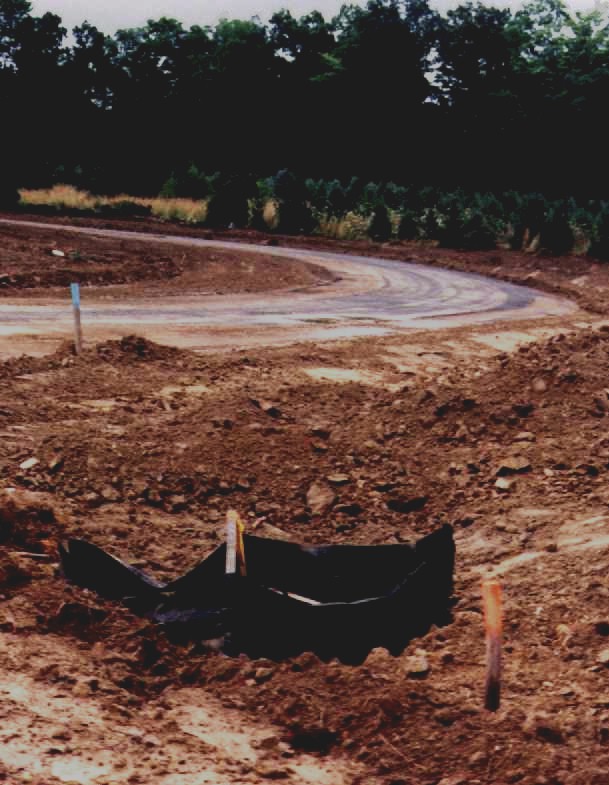
Figure 4: Silt fence not working
|
|
|
| |
|
| The Silt Fence Innovations
System: is said to eliminate trenching and backfilling, the high
maintenance of trenching equipment, fence material overlap (waste),
the use of heavy equipment, tamping and rolling of trenched fencing,
and minimizes the wash-out or blow out at the bottom of the fence. |
|
| |
|
| Silt-Loc: is a Geo-Textile
material that is constructed with an "integrated line" which
allows it to be installed with the Blade-Loc tool. The material is
plowed into the earth with the use of a vibratory-type plow attachment
mountable on various types of construction equipment. The Geo-Textile
material allows water to pass through it at a controlled rate while
allowing silt material to settle. It is used extensively around environmentally
sensitive areas at construction sites. A new application is the installation
of a deeply-plowed Silt-Loc to prevent landslides, protect slopes
and stabilize soils. |
|
| |
|
| Silt-Loc is designed to
work with Blade-Loc. Silt-Loc can be ordered in 250'(80m), 500'(160m)
& 1000 ft.(330m) size rolls that fit on the machine for automatic
unrolling. The Silt-Loc product is durable, UV resistant and made
of an industry standard Geo-Synthetic material. |
|
| |
|
| Erosion Control Structures |
|
| Sediment Traps |
|
| Used as a
temporary control device, sediment traps are designed to hold
water long enough for the sediments to fall out before releasing
to open water bodies. Used independently or in conjunction with
diversions, they are formed by excavation and/or embankments
and must include a check dam.
When the traps are removed at the
end of construction after the area has become stable, the
sediment must be removed and the excavated trap must be backfilled.
|
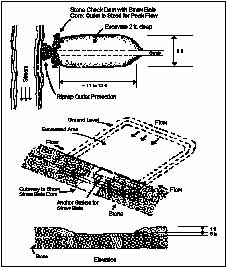 |
|
|
| |
|
| Perimeter Protection |
|
| Erosion Control Products/Structures |
|
|
Construction Fencing
|
|
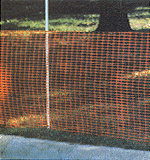 |
Orange Safety
Fence: is made from high density polyethylene; this fencing
is flexible, highly visible and easy to use. This material will
not corrode or rot, even after extensive outdoor use. This product
can be used with durable, fiberglass T-Posts which make fence
installation quick and easy. The primary purpose of this product
is to provide heavy-equipment drivers with a boundary that is
easy to spot while operating their vehicles. |
|
|
| |
|
|
Survey Tape
This tape is used for many purposes related
to land surveys or tree cutting operations. Red tape in usually
used to mark property boundary marker locations and the other
colors are used for marking trees to be cut or to mark the
way to some specific point in the forest. This is another
product that will assist in specifying boundaries for heavy
equipment operators in order to avoid compaction in sensitive
areas and to avoid encouraging erosion.
|
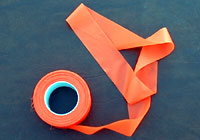 |
|
|
| |
|
| Traffic Area Stabilization |
|
| It is necessary to stabilize
the entrances of a given construction site in order to create a threshold
to minimize disturbance by vehicles tracking mud in and out of a site.
The entrances should be designed so that all traffic entering and
exiting the site must travel the length of the entrance in order to
minimize tracking. |
|
| |
|
| Erosion Control Structures |
|
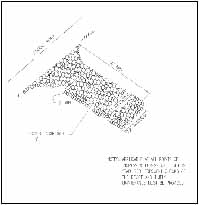 |
Construction Drives
Construction drives are a critical part of the erosion control
plan of a construction site. They reduce the amount of sediment
leaving the site on the tires of trucks and prevent the erosion
of temporary roads until they are permanently stabilized.
These drives are made with a 6 inch layer of 2 to 3 inch coarse
aggregate and are usually installed where a permanent road
will be sited so that the aggregate does not have to be removed
after construction, thus reducing cost.
|
|
|
| |
|
| |
|
|
|




